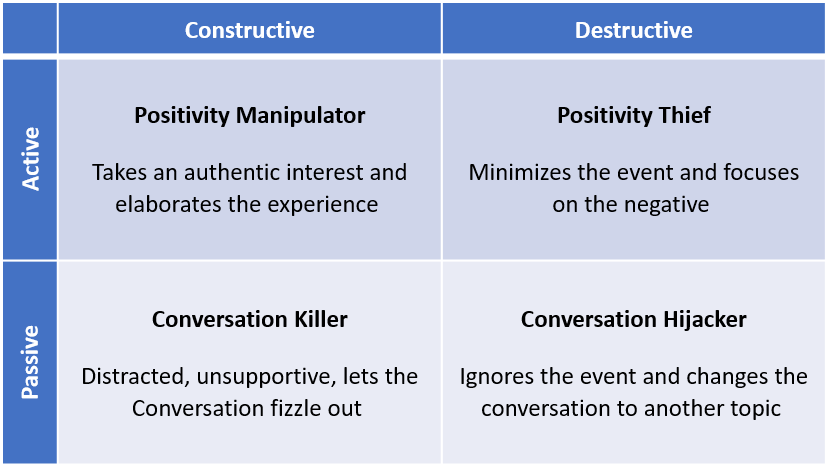
Benefits of Active Constructive Responding
Benefits of Active Constructive Responding
 There are four ways people tend to respond when others share information with them. This matrix demonstrates that responses can be active or passive and that they can be constructive or destructive.
There are four ways people tend to respond when others share information with them. This matrix demonstrates that responses can be active or passive and that they can be constructive or destructive.
Active Constructive Responding (ACR) is the preferred method of responding to others and is a cornerstone of good interpersonal communication skills. Through ACR the responding party provides feedback and builds the team.
Each of these response styles can be placed on a continuum from most constructive to most destructive (see the video at the bottom of the post). While Active Constructive Responding is the most preferred style, Passive Constructive is the least preferred style.
Fours Response Styles
Passive Constructive Responding
When someone is describing an issue or an event and the receiver does not fully acknowledge the sender, they are using passive constructive responding. A person using this this response style will come across as being uninterested and maybe even condescending. Their interest in the sender is obviously absent. The receiver response with a lack of enthusiasm and low energy. This form of responding does more damage than any other because it leaves the sender with the impression that they are unworthy of a response. Verbal: Quiet with limited inflection. Non-Verbal: Turned away from the sender, absent smile, and limited eye contact.
- Sender: Our department just received the grant we applied for!
- Receiver: [Pause – while looking at the computer screen] That’s nice…
Passive Destructive Responding
The receiver half-heartedly acknowledges the issue or event and then turns the conversation toward their own interests. “You just had a baby, that’s cool. Did I tell you we bought a new house?” This receiver turns the focus toward themselves and hijacks the conversation. They are often referred to as a one-upper; a person who steels the joy from others by comparing themselves to the sender. When they don’t use the one-up method they may choose to ignore the sender. Verbal: Quiet with limited inflection. Non-Verbal: Turned away from the sender, absent smile, and limited eye contact.
Hijacking
- Sender: Our department just received the grant we applied for!
- Receiver: Yeah, so did my department. I heard our grant was almost twice as much as yours.
Ignoring
- Sender: Our department just received the grant we applied for!
- Receiver: [No response] or [An irrelevant comment] Did you verify we still have the conference room tomorrow?
Active Destructive Responding
The receiver focuses their response on the negative aspects of the issue or event while minimizing the good. An Active Destructive Response is deflating and has a direct impact on the self-esteem of the sender. Someone responding in this way is demonstrating a lack of care and compassion for the sender. The will let the conversation fizzle out while leaving the sender to consider only the negative aspects of the conversation. Verbal: Will likely use inflection or increased volume. They may come accross as sarcastic and possibly laugh at the sender. Non-Verbal: Turned toward the sender with increased dominance. They may fold their arms. They will likely increase their presence by extending or expanding their body. Such as leaning back in a chair and extending their legs or leaning forward and spreading their knees.
- Sender: Our department just received the grant we applied for!
- Receiver: Get ready to work 18-hour days. There is no way your team is ready for all that responsibility.
[NOTE: as a receiver we may see the negative aspects of the sender’s message and may feel compelled to help them see the challenges as well. Don’t mistake guided discover for active destructive responding (ADR). See the note under active constructive responding (ACR) for more information.]
Active Constructive Responding
The receiver helps the sender hunt for the good stuff. They take an authentic and genuine interest in the information being shared and build the conversation with good clarifying questions. They help the sender build the conversation and enable them to see all aspects of the news they are sharing. Verbal: The volume will vary depending on the circumstances. They will use positive language and will use inflection that would be appropriate for the situation. They will speed up and slow down the rate of their speech as appropriate. Non-Verbal: Turned toward the sender with an open and welcoming posture. They will use body language that demonstrates openness. Typically they will lean forward, nod their head, and make eye contact.
- Sender: Our department just received the grant we applied for!
- Receiver: Cool! You’ve been working on that for a while! What’s next?
[NOTE: ADR starts and ends with a focus on the negative aspects of the conversation while ACR begins and ends on a positive note. Often times we see the negative aspects in a situation that others may not. If we feel obligated to help them see those we can delay that urge until after the initial joy of the moment has passed naturally. Consider the example under ADR above where the receiver realizes that the sender will probably need to put in more hours because their employees lack the adequate training or skills to meet the increased demands. The receiver may still need to discuss these with the sender, but only after initially acknowledging the joy of the sender. By gradually building the conversation (ideally through a series of good clarifying questions) the receiver can help the sender prepare for negative aspects of what they currently believe to be great news.
Active Constructive Responding works with anyone
What I really like about this model is that it works with anyone I encounter. Whether I’ve known them for years or just met them I can employ ACR to provide and authentic and genuine interaction with them. By using the tips below we can increase our use of ACR and thereby increase the authenticity and depth of our relationships – even if only for a brief encounter. By using ACR we show other parties involved in the conversation unconditional respect. In doing so we are likely to increase the potential of them showing a similar level of respect for us.
Factors that lead to using Non-AC Responses
There are countless factors that lead to using Non-AC responses. Some of those include:
- Perceptions based on previous experiences with the person
- Being distracted by other events in our lives
- Being ill or in pain. We may find it hard to use ACR when we have a headache or stomach ache.
- Being in a foul mood
- Lack of familiarity with the other party
- Lack of interest in the other person’s message
- A disagreement with the other person’s message
Factors that lead to using ACR
Using Active Constructive Responding, especially when we are compelled to use a Non-AC response might be difficult. Below are a few common reasons that ACR is a natural response.
- A genuine interest in the topic of discussion
- A genuine interest in the other person
- A desire to fully understand the other person’s perspective
Tips for increasing the use of ACR
- Turn towards the other person
- Make eye contact with them while they speak and occasionally while you speak
- Nod your head occasionally so they know you’re listening
- Look at them, not past them. Track them with your head and eyes when they move
- Lean toward the speaker
- When they are finished speaking respond sincerely with your thoughts in a positive tone. This might include; WOW!, That’s cool, I’m so happy for you, or that’s interesting…
- Ask a follow up question; tell me more, what’s the next step, when did you find out, etc. Ensure that the question is open ended.
Active Constructive Responding Video
